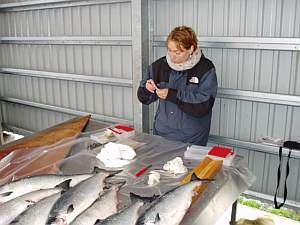Analysis of historical Atlantic salmon scale data has shown that the proportion of salmon from European rivers which successfully make their way to the rich feeding grounds off West Greenland has dropped by more than 75% in recent decades. The Atlantic Salmon Trust and its partners are now spearheading a project to help solve the mystery of why this is.
Advances in microsatellite DNA profiling now make it possible to identify salmon caught at sea to their natal region and, in some cases, to their river of origin. Building on this work, the new project will use existing genetic databases to carry out a pilot study to determine the region and/or river of origin of a range of contemporary samples from fish scale and tissue collections from Atlantic salmon captured recently in the fishery at West Greenland.
Atlantic salmon were first recorded from Greenland waters in the 1780s but it was the 1960s before a full commercial distant-water fishery for salmon developed. Since 2001 this has been restricted to an internal-use fishery through conservation agreements adopted internationally through the North Atlantic Salmon Conservation Organization (NASCO). To date we have had no way of assessing which of the weaker populations of salmon are impacted by the remaining subsistence fishery.
 Over the past five decades scientists have collected scales and tissue samples from the West Greenland fishery through an international sampling programme. These have been used for a wide range of analyses, including in more recent years, genetic assignment of salmon to their continent of origin. This work has shown quite dramatic changes in the proportions of salmon from North America and Europe appearing in the samples. Originally some 40% of the fish caught along the West Greenland coast were of European origin but in more recent years this proportion has dropped to less than 10% – but we have no idea why.
Over the past five decades scientists have collected scales and tissue samples from the West Greenland fishery through an international sampling programme. These have been used for a wide range of analyses, including in more recent years, genetic assignment of salmon to their continent of origin. This work has shown quite dramatic changes in the proportions of salmon from North America and Europe appearing in the samples. Originally some 40% of the fish caught along the West Greenland coast were of European origin but in more recent years this proportion has dropped to less than 10% – but we have no idea why.
Equally puzzling is the fact that almost all of the salmon at West Greenland will return to their native rivers as the large and much sought after, spring or multi sea-winter-salmon. For the first time in 25 years the overall abundance of these salmon has begun to increase in recent seasons, although it is still low in historic terms and many stocks contributing to the fishery are still likely to be below their conservation limits. Forecasts of abundance for 2013 and 2014 are less optimistic.
Thanks to work carried out as part of the recently completed SALSEA Merge programme (http://www.nasco.int/sas/salseamerge_documents.htm) European scientists can now assign, with remarkable accuracy, individual salmon back to their region or river of origin.
A consortium of scientists from Europe and North America has been formed to re-examine scales and tissue samples gathered over recent years from the West Greenland fishery, in order to crack the genetic code. This will make it possible to assign fish back to major European rivers, particularly in the UK and Ireland. It is hoped that this work will lead to much deeper knowledge of the occurrence of individual salmon stocks along the West Greenland coast, particularly the weaker stocks and inform management of the fishery in the future . It should also provide an insight into why, and how, the proportions of North American and European salmon stocks are changing over time.
The initial work will concentrate on European stocks, but a similar database is near completion in North America. A full assessment of the West Greenland samples, over the decades, is now a distinct possibility.
“When, as part of SALSEA, we started our intensive sampling programme in West Greenland some years ago, assignment of stocks back to their region of river of origin was only a pipe dream”, said Tim Sheehan, a senior biologist at NOAA’s National Marine Fisheries Service, Woods Hole, Massachusetts. “It’s hard to believe we are now on the cusp of such an exciting breakthrough. Full credit is due to all of the laboratories and the dozens of individuals who have contributed to the programme over the decades.”
This new West Greenland salmon genetics programme was spearheaded by the Atlantic Salmon Trust which seed funded the programme and coordinated the evolving partnership. Other major players include NOAA (National Oceanic and Atmospheric Administration), US Geological Survey, Agri-Food and Bioscience Institute of Northern Ireland, NASCO’s International Atlantic Salmon Research Board (IASRB), Marine Scotland, University College Cork and Queens University Belfast through the Beaufort Marine Research Award and a range of partner laboratories in Europe.
“Having coordinated the work of SALSEA teams throughout Europe to provide dependable genetic markers, it’s really exciting to see these tools being applied to shed light on practical international fisheries management issues,” said Phil McGinnity, Principal Investigator of the Beaufort Fish Populations Genetics team at University College Cork.
“As is the case with all mixed stock fisheries our major concern is with the weaker stocks and how these are impacted by the fisheries. The aim of this new study is to identify regional or individual river stocks, and the extent that they contribute to the fishery, so that their status can be taken into consideration in management terms,” added AST Chief Executive Tony Andrews.
The West Greenland Genetics Programme is funded by the Atlantic Salmon Trust, AFBINI and the IASRB. For further information contact Professor Ken Whelan, Research Director of the Atlantic Salmon Trust on: +353 867835000




















